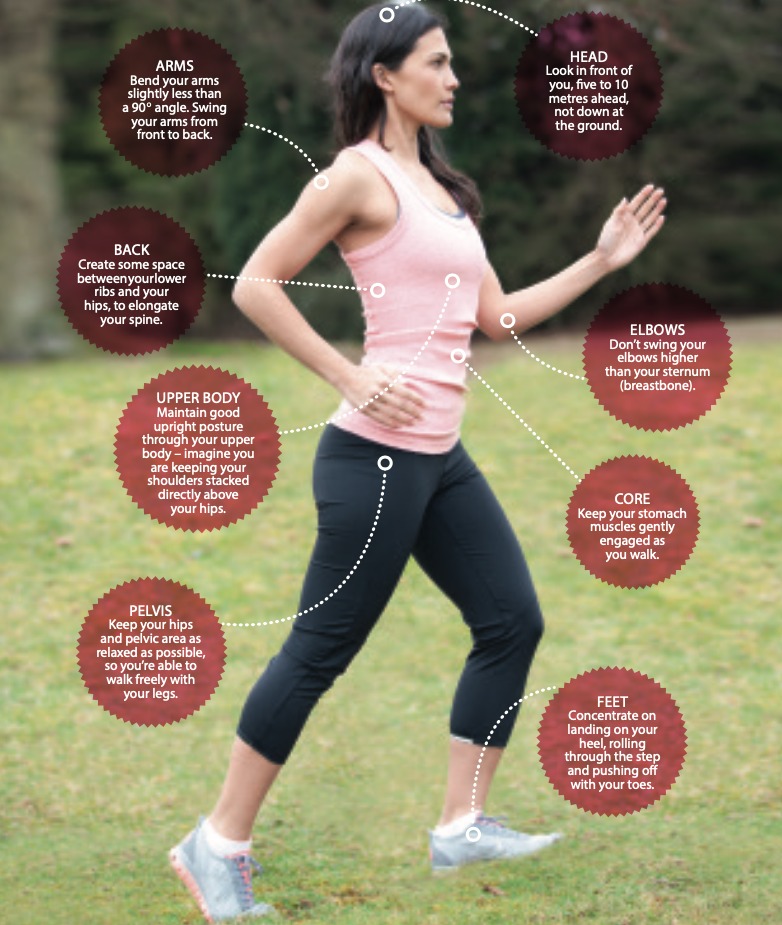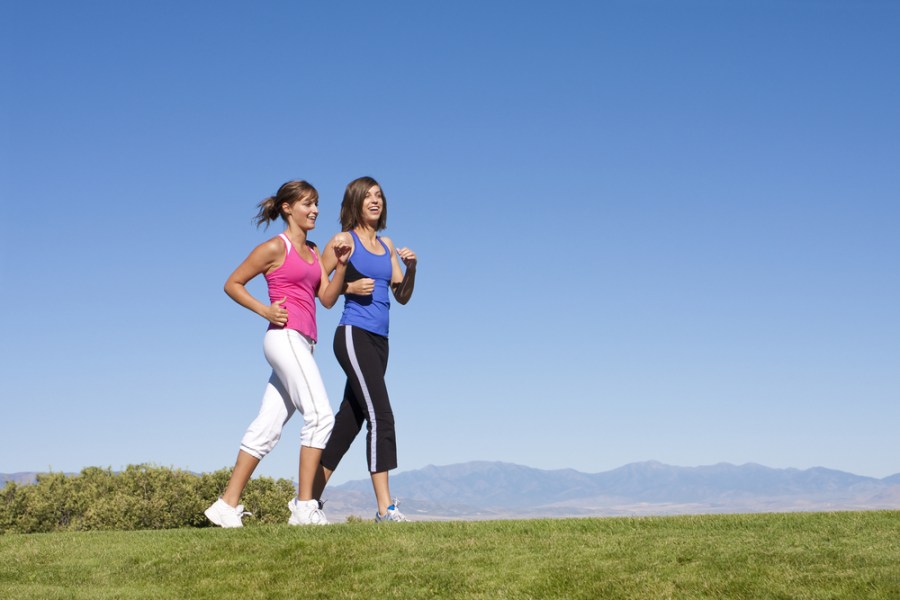If you can’t run due to the high impact nature of running causing problems with your joints, or you simply don’t enjoy it, walking is a great way to burn fat. Provided you do it regularly (four times a week or more) and you work up a good pace when you’re doing it, you will burn calories and get fitter.
However, technique is important when it comes to getting the most out of your walking and burning optimum calories. You should be trying to push yourself, but good posture is also important.
Good form is the foundation of your walking plan. Not only will it help you walk faster and longer to reap more benefits, it will help you feel more energetic and look slimmer. Small tweaks to the way you walk can have a big impact on your posture, body shape and weight-loss results. They can also help you walk more comfortably and stay injury free. Follow these guidelines to perfect your stride…
Stand tall

Try to create as much distance between your ears and shoulders as possible. This will help prevent hunched shoulders and poor posture. Keep your head in line with your spine and have your chin parallel to the ground – don’t tuck in your chin or tilt it back, and this will interfere
with your stride.
Use your imagination
To help maintain correct walking posture, imagine a vertical line from your big toe to the centre of your knee and up to your pelvis.
Lift your pelvis
To stabilise your pelvis, keep the front of your pelvis lifted and engage your core by keeping your abdominal muscles slightly contracted. To get the right position, imagine your pelvis contains a bowl of water and aim not to spill any as you walk. This will support your back, flatten your tummy and reduce pressure on your joints.
Don’t over stride
Take shorter rather than longer strides – this will be better for your joints as well as your posture.
Use the whole of your foot
With each stride, remember to walk through the whole of your foot. Strike the ground with your heel and roll your foot through to your toes. Focus on pushing off from the ground through all your toes to help activate your glutes and keep your feet aligned. A recent study at the University of Utah found people who walk heel-first use 83 per cent less energy than those who walk on their toes, and 53 per cent less than those who walk on the balls of their feet.
Don’t forget the arm swing
For maximum efficiency, use your arms as well as your legs! Walking with straight, rigid arms will impair your technique and make you walk slower. Another common mistake is to allow your arms to swing from side to side rather than backwards and forwards. Instead, bend your arms at the elbow at a 90o angle, and swing them forwards and slightly towards the centre of your body. This will rotate your body, helping tone your waist. Using your arms in this way also helps propel you forward. Basically, the faster you swing your arms, the faster your legs will move.
Adapt if you need to
If you’re new to power walking, it may be tiring to begin with. If this is the case for you, use your arms in the way described above for five or 10 minutes, then lower your arms and just let them swing naturally to allow them to recover. As soon as you feel rested, raise them again. To build strength in your arms, you could try doing some upper body exercises with dumbbells to increase your endurance.
Avoid tension in your hands
Remember to keep your hands in a relaxed fist – don’t clench! If your hands are tight it will create unnecessary tension in your arms and shoulders. It also uses up quite a bit energy – and you want to keep all your energy for walking!
Engage your glutes
To tone up your bottom, concentrate on pushing off with your big toe and little toe after you roll through your heel with each stride. This will help engage your glute muscles more effectively.
Keep the spine lengthened
Try to create some distance between the bottom of your ribcage and the top of your pelvis. This will naturally lengthen your spine. Drop your shoulders and imagine that you are leading from your sternum as you walk, which will keep your chest open and your ribcage slightly forward. This will also make it easier for you to breathe more efficiently and give your muscles more oxygen.
Focus on your breathing
For optimum breathing technique, breathe in through your nose and out through your mouth. Your nasal passages offer more resistance to the air than breathing through the mouth, and this will help keep your lungs strong and elastic. Breathing out through your mouth will help cool you down. Try to take deep breaths that fill your lungs – short, small breaths won’t utilise your lung capacity to the full.
Look ahead
Focus your eyes on the ground about five to 10 metres ahead. If you need to look at the terrain closer to your feet, aim to tilt your eyes, rather than your head. If you extend your head forward your body will go out of alignment and you could place excess strain on your neck and shoulders, which will put you off balance and lead to undue fatigue.








